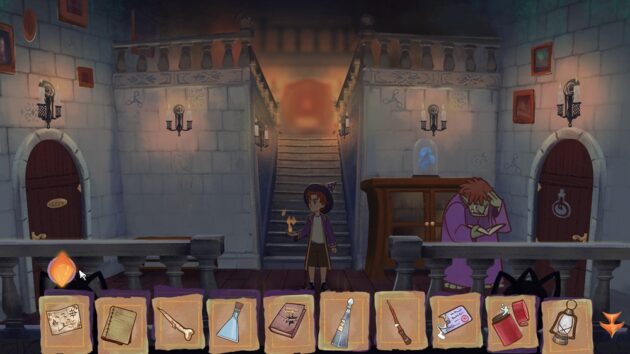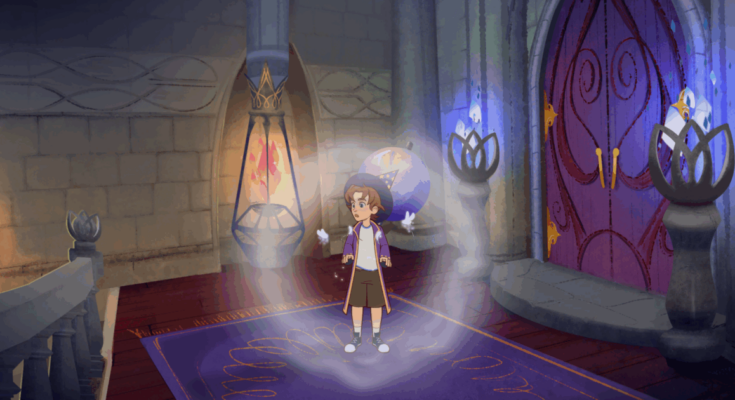Among the most popular point and click adventures of the 90s, Simon the Wizard occupy a special place. Born in 1993 from the mind of Simon Woodroffe and published by Gentle Adventurethe game entered the hearts of its players thanks to its “British humor” and brilliant writing reminiscent of LucasArts classics. Over the years, the series unfortunately changed hands and direction several times, losing some of its original charm.
Today, more than thirty years later, the young magician once again has people talking Simon the Wizard Originsdeveloped by Italians Small Studio under the guidance of Massimiliano Calamai. This title is not a sequel, but a prequel that tells the story of Simon’s origins and his first encounter with the Wizarding World. The goal is clear: return the series to its roots, restoring the light-hearted spirit and classic structure that made the original title famous.
Really back to basics
The first Simon the Wizard It established itself as one of the most successful graphic adventures of its time, a spiritual heir to the great LucasArts classics but with its own personality. The combination of clever puzzles, biting writing and real, irresistible English humor made it a cult title, capable of captivating an entire generation of players.
But as time went by, the series lost its way. Attempts to update it to modern tastes – between the three-dimensional graphics, action components, and unconvincing stylistic choices – ultimately distanced it from what made it special: its lightness, dialogue rhythm, and puzzle quality. Simon’s identity, with his sarcasm and disillusioned way of dealing with magic, is weakening.
Simon the Wizard Origins perhaps born in response to that deviation. Smallthing Studios has decided to take a step back to take a step forward: restoring the original formula and revitalizing it with modern sensibilities. Get rid of superfluous elements, get rid of 3D, get rid of forced action. Instead, it’s back to classic “point and click,” based on exploration, dialogue, objects to combine, and situations to resolve with logic and irony. The result is a title that doesn’t simply quote the past, but makes it current: honoring its roots, but also designed to be enjoyed by those discovering Simon’s world today.
A reluctant wizard full of character
The story follows young Simon who is still unaware of his fate. Having recently moved into a new home, he accidentally ends up in the Wizarding World, where he must find a way to return to the midst of spells, prophecies, and reckless wizards. The tone remains ironic and light, but the writing Origin stands out clearly compared to the German chapters: lively dialogue, witty quotes, and well-calibrated humor making the narrative a very strong point.
 Despite the light atmosphere, this game is by no means simple. After the initial introductory section, the difficulty increases quickly thanks to a mechanic that allows you to modify objects with different magic hats, multiplying the possible combinations. The puzzles are varied and well-constructed, capable of stimulating even veterans of the genre.
Despite the light atmosphere, this game is by no means simple. After the initial introductory section, the difficulty increases quickly thanks to a mechanic that allows you to modify objects with different magic hats, multiplying the possible combinations. The puzzles are varied and well-constructed, capable of stimulating even veterans of the genre.
The interaction system is clear and intuitive, with active points always able to be highlighted via a dedicated button. Some minor slowdowns are obvious, such as the requirement to use certain objects directly on Simon, rather than from inventory, but these are the details. The only downside is an integrated hint system, which could lighten up the second half of the game, where the puzzles become more complex. However, it’s a conscious choice that leaves players feeling happy – or frustrated – at being able to hold their own.
Interesting but sometimes stubborn design
As in many graphic adventures with a classic flavor, Simon the Wizard Origins it is not without structural rigidity. Some situations reveal a design that is a little too tied to the logic of twenty years agowhere the solution to a puzzle depends less on the player’s intuition than on “unlocking” the right dialogue sequence.
For example, you know perfectly well how to proceed – which objects to use or where to intervene – but you can’t do it until Simon talks to a certain character or has exhausted all the available dialogue. This leads to moments of frustration, especially when the connection between the conversation and the puzzle is less clear. It’s a familiar feeling to those who lived in the golden age of point-and-click adventure, but today it might sound like an unavoidable limitation.
In addition, sometimes to obtain important information you have to examine the same object several times or repeat actions already performed. This isn’t a huge fault, but it does disrupt the pace of the adventure and feels as if the game is artificially holding the player back, instead of rewarding their logic or curiosity. It’s the kind of design that does more to replicate a “period feel” than actually modernizing the experience.
That is, when the game relies on pure reasoning and lets logical connections guide the player, Origin shine: the puzzles are stimulating, coherent, and often ingenious. In those moments where the game trusts the player’s intelligence, it manages to give its best.
An art that smells like a brush
From an artistic point of view, Simon the Wizard Origins it’s a little gem. That hand drawn cartoon style it immediately brings to mind the adventure aesthetic of the 90s, but reworks it with a modern sensibility. Every screen is treated to detail: the warm light in the bar, the enchanting feel of the forest, the subtle textures of the books and potions. They convey the sensation of being inside a living illustration, each element of which has been traced with precision and affection.
 The artistic direction does not aim at realism, but at building a coherent and recognizable world, where each setting reflects the ironic and surreal spirit of the series. Some of the animations are simplified, and we see the use of small tricks to cover up certain technical limitations – such as placing Simon in front of an object to avoid complex animations – but the overall result is warm and welcoming, like a drawing on paper come to life. It’s a style that is fondly remembered and returns the genre to an artisanal identity that is increasingly rarely seen today.
The artistic direction does not aim at realism, but at building a coherent and recognizable world, where each setting reflects the ironic and surreal spirit of the series. Some of the animations are simplified, and we see the use of small tricks to cover up certain technical limitations – such as placing Simon in front of an object to avoid complex animations – but the overall result is warm and welcoming, like a drawing on paper come to life. It’s a style that is fondly remembered and returns the genre to an artisanal identity that is increasingly rarely seen today.
Conclusion
Simon the Wizard Origins it’s a successful return, able to revive a graphic adventure icon with respect and wit. Smallthing Studios has achieved its goal: returning the spirit of the original to Simon without giving up the modern presentation. It’s not a perfect game – and some of the stiffness in its design is noticeable – but it’s honest, well-written and, most importantly, made with passion. A title that harks back to nostalgia, but can still teach newcomers something about the true meaning of point-and-click adventure.



